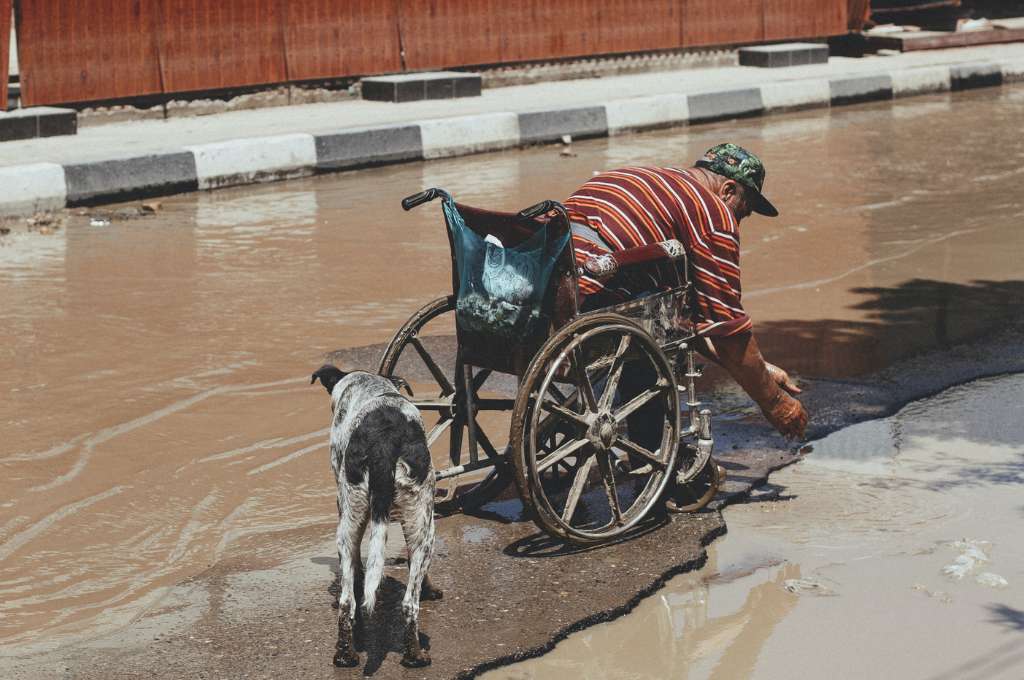In November 2021, Israeli minister Karine Elharrar was unable to attend the COP26 summit in Glasgow. Karine lives with muscular dystrophy, and the summit was inaccessible to her on her wheelchair. Her concerns served as a metaphor for the historical exclusion of disabled individuals’ lived realities in the conversations surrounding climate change and disaster relief.
The increasing frequency of extreme weather events and natural disasters, rising sea levels, floods, heatwaves, deforestation, droughts, desertification, and water shortages are some of the adverse impacts of climate change. Climate change affects food production and access to safe drinking water, shelter, and livelihoods, and leads to destruction of health infrastructure, among other problems. Invariably, the most vulnerable, marginalised sections of society are the first to have their lives and basic rights to food, water, and shelter undone by these changes.
Why are persons with disabilities especially at risk during disasters?
Disabled individuals constitute the world’s largest minority—with an astounding 15 percent of the global population, that is, 30 million people, living with an intellectual or physical disability. Yet, the unique challenges of persons with disabilities (PwDs) are as invisible in discourses surrounding climate change and disasters as they are in conversations about the resultant mental health challenges.

When natural disasters make resources scarce, PwDs are the first in need of help and yet the last to receive it.
India, in particular, is home to approximately 3 crore PwDs, of which close to 1.3 crore people are employable, but only 34 lakh among them are actually engaged in formal or informal employment. This is because disabled people are often stuck in a cycle wherein societal structures and systems render most public life inaccessible to them. Thus, children born with disabilities may or may not have access to the necessary health and educational infrastructure, depending on socio-economic status, geographical location, and so on. Therefore, disabled individuals run the risk of remaining uneducated, living below the poverty line, and being cut off from availing the health infrastructure and medical care they would need at different points in their life.
When natural disasters make resources scarce, PwDs are the first in need of help and yet the last to receive it. In relief camps, there is a dearth of accessible housing and sanitation facilities. This is accompanied by an inadequate healthcare system that is focused on pathologising and ‘treating’ symptoms of a disability rather than helping with adaptation and improving quality of life. Barriers such as prejudice, social stigma, and exclusionary public policy only worsen the existing vulnerabilities of disabled and mentally ill persons, especially if they are women. Reports by the Internal Displacement Monitoring Centre (IDMC), South Asia, on the relief camps in Bangladesh after Cyclone Amphan include narratives of disabled women. They were unable to use the makeshift washrooms or bathing areas due to fear of harassment and abuse from men. The women attributed this violence to men feeling frustrated due to unemployment and substance abuse.

Understanding the links between climate change and the mental health of PwDs
The issues of climate change, mental health, and disability have been historically viewed as mutually exclusive and unrelated concerns. However, advocacy to consider climate change as a human rights issue is incomplete unless interlinked with disability rights and mental health.
Limited mobility and self-preservation skills during climate change–related emergencies can adversely impact the mental health of those living with psychosocial and physical disabilities. Research demonstrates that rising temperatures, deforestation, and increasing number of natural disasters, and the consequent losses incurred—both material and emotional—result in mental health concerns such as depression, post-traumatic stress disorder (PTSD), suicidality, and violence. Climate change–related impacts can also lead to job loss, force people to move, or cause a loss of social support and community resources—all of which have mental health consequences.
When natural disasters strike, people with disabilities face a greater risk of being separated from their usual carers and assistive devices.
Disabled individuals may not only lack access to the necessary resources for surviving emergencies but also be cut off from larger systems of social support and rehabilitation resources that might be available to the mainstream, able-bodied community. In a study on Tropical Cyclone Pam, which hit Vanuatu in 2015, 60 percent of people with disabilities—compared to 47 percent of people without—reported that, before the cyclone, there was a lack of safety information on what to do in an emergency. After Cyclone Amphan struck Bangladesh in May 2020, 71 percent of people with auditory or hearing disabilities said that early warning systems were not accessible, while 90 percent reported challenges related to walking or climbing stairs, and said evacuation centres and/or their sanitation facilities were inaccessible. People with disabilities also face a greater risk of being separated from their usual carers and assistive devices while fleeing, which could exacerbate their vulnerabilities during displacement. Following the 2004 tsunami, conservative estimates by Human Rights Watch show that many people with disabilities in India, including several hundreds of children with intellectual disabilities, were left destitute after being separated from or even abandoned by family members, who had hitherto provided financial support and care.

There is increasing evidence that disabled individuals face a higher risk of experiencing mental health concerns such as depression and PTSD as well as a higher risk of suicidality when left in such a vulnerable position. The general stigma surrounding disability and its perception as a ‘burden’ means that a lot of disabled individuals hesitate to seek help for their concerns. They know that their caregivers are already grappling with the more pragmatic concerns related to their care, particularly in times when resources are scarce and supportive infrastructure is missing.
Mental health professionals need to be sensitised in their gaze towards people with disabilities—to view them as not being mere hapless victims of fate and help in cultivating agency and hope for the individuals, while becoming an active part of relief interventions and advocacy. Their mental health concerns and provision of therapy and psychiatric care for PwDs are often not independent of advocacy for their rights.
The need for inclusive disaster risk management and relief
The unique challenges of living with a disability—whether physical, intellectual, or psychosocial—are best understood by those with lived experience. Given the varied and often vastly diverse support needs of people with different disabilities, it would only be pertinent to include disabled individuals in the discourse surrounding inclusive disaster risk management policies.
Inclusive climate change policy may be accomplished through a ‘twin-track’ approach, which promotes both ‘specialist disability initiatives’ designed to include and empower PwDs and the ‘mainstreaming’ of disability inclusion into all policies, strategies, and activities. Effective and accessible early warning systems and evacuation procedures are crucial, especially for someone who may have difficulty getting out of harm’s way quickly or independently.
The scarcity of sign-language interpreters is a consistent challenge across India.
Emergency relief workers could benefit from sensitisation and training as well as necessary technical support for inclusive relief planning. For example, wheelchair users may be unable to hide under tables/chairs during an earthquake. Evacuation of these individuals when electric outages might render elevators defunct would need to be conducted using special equipment that allows a wheelchair to be lifted out and lowered from a height.
It is also important to create awareness among mental health professionals and other stakeholders about disability affirmative intervention. The scarcity of sign-language interpreters is a consistent challenge across India, as is the lack of signs for disaster-related terms in Indian sign language. Educative resources and creating awareness regarding climate change–related consequences on mental health as well as safety planning in formats accessible to disabled individuals (including manuals in Braille or training in sign language) are essential to fostering agency and self-efficacy in individuals with disabilities.
Collaboration between multiple stakeholders, including local panchayats, rural authorities, municipal authorities, disability rights organisations, as well as emergency relief professionals and medical staff is imperative to ensure that they meet the short- and long-term goals towards inclusion and rehabilitation of PwDs in emergencies.
Therefore, we need to cultivate active sensitisation among mental health professionals, emergency relief workers, and all other stakeholders for the mainstreaming and integration of disabled individuals, as these form the first step in any major inclusive climate action or advocacy. However, truly ending this vicious cycle involves educating people and addressing the stigma and prejudice that is at the root of the exclusion of PwDs, and the conscious visibilisation of disability in public life.
This article has been edited in parts for IDR. The original version was published in MHI’s fifth edition of ReFrame: Mental health and climate justice.
—
Know more
- Learn more about actions that can be taken for disability-inclusive disaster risk management.
- Read about how benevolent ableism can further marginalise and discriminate against people with disabilities.




